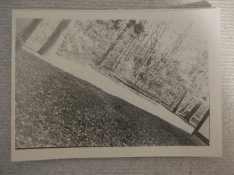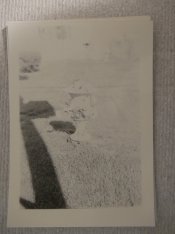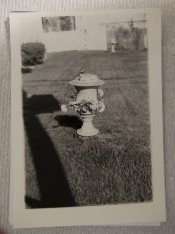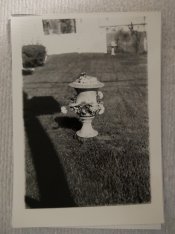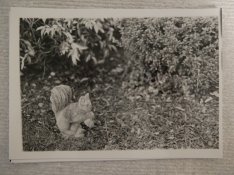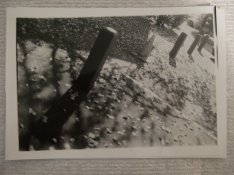My new bulb, suggested to my by Donald Qualls in reply # 20, and a new box of 25 sheets Ilford Multi-Grade 5x7 arrived today from Freestyle Photo. I had the afternoon off so was able to try them out. Starting off I tried the suggested tests in reply # 54 and came up with the following, developing some of the older –suspect– IMG paper, for the full recommended 90 seconds (given the way I count probably longer) in 14:1 Ilford Multi-Grade Paper Developer, f/16 (dimmest my ancient enlarger will go) and 11 inches measured between the enlarger's lens and the top surface of the easel:
- No safelight, no exposure, straight to development in pitch blackness. Result: All white.
- Exposed one frame from my first, and so far only, roll of film, for 1 second, then developed in pitch blackness, no safelight involved at any time. Result: A much better picture than any achieved in my first go-around, but over-exposed looking (i.e. much brighter/whiter than the picture I thought I took). Definite white border around the picture.
- Same as above, but with the new safelight on when pulling the paper out of the box, positioning on the easel and during development. My timer turns the light off when the enlarger is on. Result: Same as test # 2.
Note: the safelight was in a reflector pointed up toward the corner of ceiling farthest away from the enlarger, trays and paper storage area. The new SL is considerably dimmer than the older one. I did not use the old SL at any time.
From these tests I have tentatively concluded the first safelight is safe and all my old paper is not ruined. A few dollars for a second bulb is no big deal and having a little extra paper on hand can't hurt. I continued my darkroom time "safe" in the knowledge just mentioned for 14 more sheets and came to some new conclusions, for which the forum is welcome to comment on:
- Most images look fairly good with 2 seconds enlarger exposure at f/16 and 11". 1 second would produce a decent, but blown-out image and 4 seconds was recognizable but heading toward solid blackness.
- Some film frames needed more time. One I tried for 1, 2, 4, 6 and 8 seconds (where 1 second = one push of the button on my timer which was set to 1 second) and I recon could have gone for 10 seconds and looked even better! Another film frame looked best at 3 seconds. Yet another could probably have had better results had I done another sheet for 3 seconds. Could this difference be due to the exposure levels of the film while in the camera? The 3 second exposure was from a frame that was noticeably dark and probably originally underexposed.
- IQ difference between the Ilford Multi-Grade paper and the no-name Multi-Tone paper is hardly, if at all, perceptible, but the Multi-Tone is half the cost.
Finally I managed to get through to Beseler customer service and was informed my enlarger model is so old they cannot readily identify it and therefore no longer support it. The CS rep said my film carrier looked odd to her and she offered me the equivalent part for the Cadet II which given the measurements shown in the pictures she emailed me will likely not line the film frame up to the same center point as the carrier on my enlarger and so I have decided not to buy that replacement part for now.
Below I have attached some of the prints I developed today. Since I lack a scanner I had to use my digital camera to do the best I could. Forgive the terrible lighting. These pictures are:
778: The first test image, right after the blank white sheet, 1 second exposure.
779: 2 second exposure, Ilford Multi-Grade
780: 4 seconds
781: 6 seconds
782: 8 seconds
783: 8 seconds exposure, Multi-Tone
784: 2 seconds exposure, likely could have been improved at 3.
785: 2 seconds
786: 3 seconds


